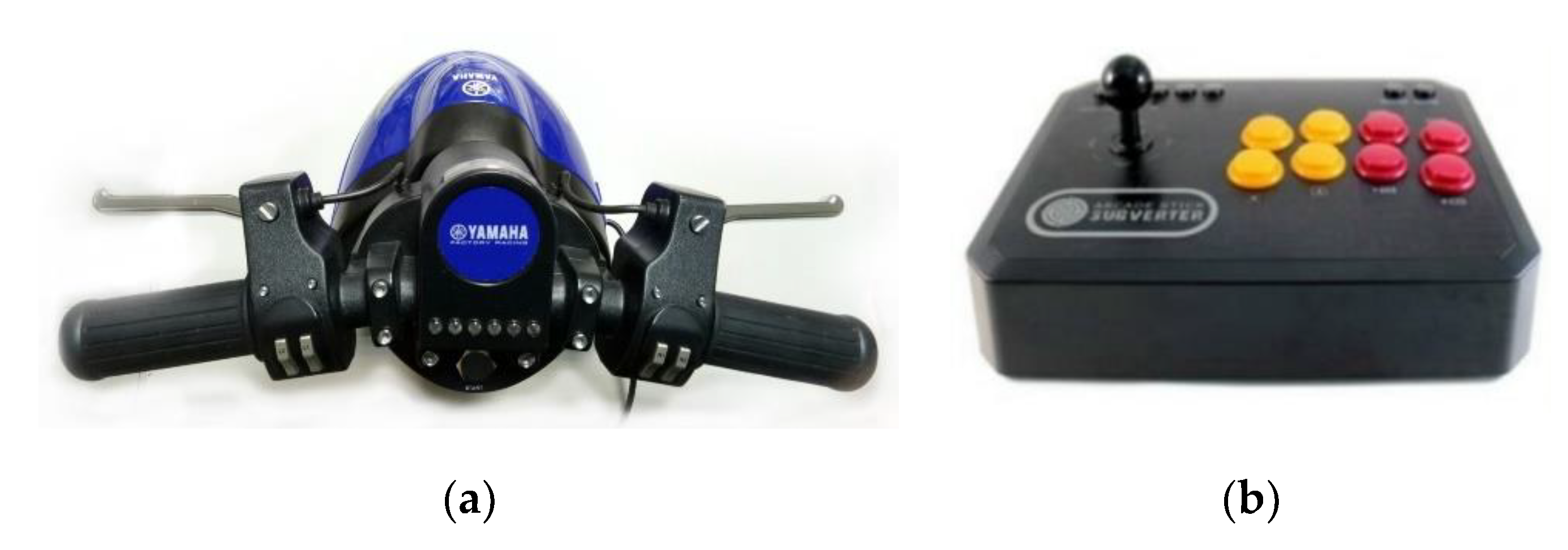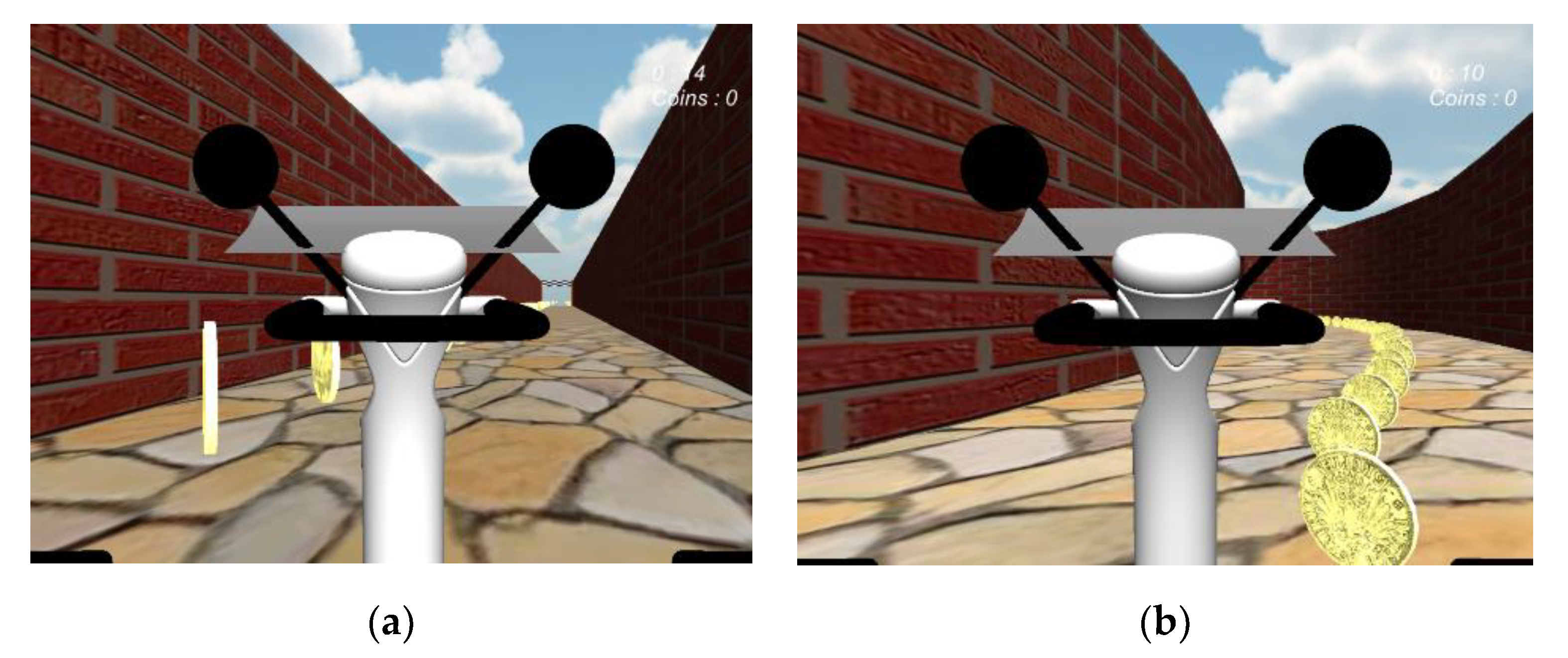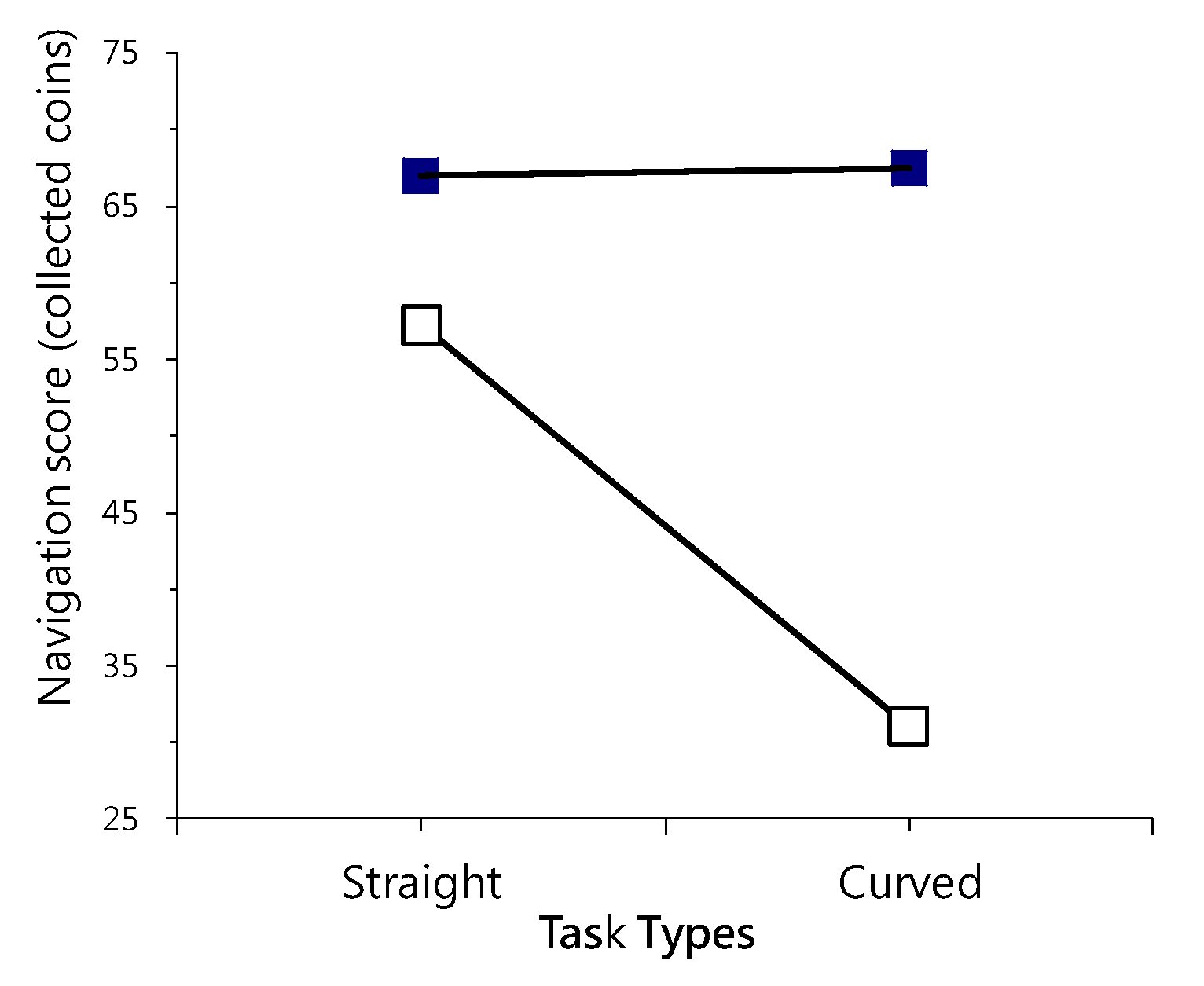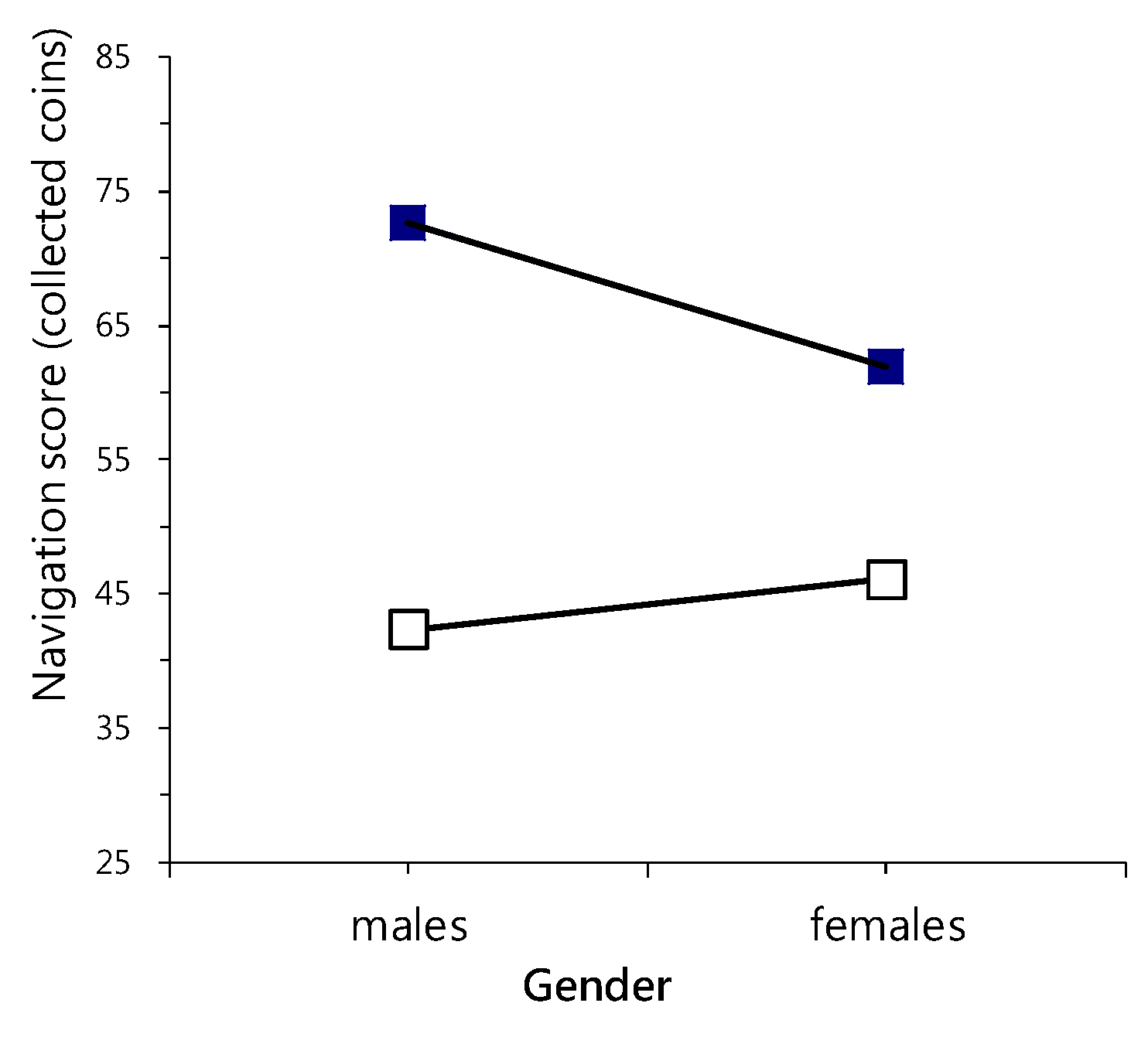The Effects of Age, Gender, and Control Device in a Virtual Reality Driving Simulation
Abstract
1. Introduction
- (1)
- there is an age effect;
- (2)
- there is a gender effect;
- (3)
- there is a control-device effect;
- (4)
- there is a task-type effect; and
- (5)
- there are interactions between navigation performance, age, gender, task type, and control device.
2. Materials and Methods
2.1. Participants
2.2. Task Types
2.3. VR Control Device
- (1)
- Handlebar: Had the form and appearance of motorcycle handlebars (Figure 1a, Yamaha game handlebar). Two hands were needed for operation. The user twisted the right handgrip to accelerate (10%) and the brake to stop.
- (2)
- Joystick: Similar to popular game control devices (Figure 1b, Rockfire QF-8000US game joystick). One hand was needed for operation. The user controlled the direction and speed by pointing the stick in the desired direction.
2.4. Procedure
2.5. Data Analysis
3. Results
3.1. Overall Results
3.2. Interactive Effects
4. Discussion
4.1. Age and Task-Type Difference
4.2. Age and Gender Differences
4.3. Age and Control Devices
4.4. Limitations
5. Conclusions
Funding
Conflicts of Interest
References
- Mott, K.K.; Alperin, B.R.; Holcomb, P.J.; Daffner, K.R. Age-related decline in differentiated neural responses to rare target versus frequent standard stimuli. Brain Res. 2014, 1587, 97–111. [Google Scholar] [CrossRef] [PubMed]
- Stevic, A.; Schmuck, D.; Matthes, J.; Karsay, K. Age Matters’: A panel study investigating the influence of communicative and passive smartphone use on well-being. Behav. Inf. Technol. 2019, 15. [Google Scholar] [CrossRef]
- Wiemeyer, J.; Kliem, A. The frequent wayfinding-sequence ion and rehabilitation—A new panacea for elderly people? Eur. Rev. Aging Phys. Act. 2011, 9, 41–50. [Google Scholar] [CrossRef]
- De Tommaso, M.; Ricci, K.; Delussi, M.; Montemurno, A.; Vecchio, E.; Brunetti, A.; Bevilacqua, V. Testing a novel method for improving wayfinding by means of a P3b Virtual Reality Visual Paradigm in normal aging. Springer Plus 2016, 5, 1297. [Google Scholar] [CrossRef] [PubMed]
- Lawton, C.A. Strategies for indoor way-finding:the role of orientation. J. Environ. Psychol. 1996, 16, 137–145. [Google Scholar] [CrossRef]
- O’Laughlin, E.M.; Brubaker, B.S. Use of landmarks in cognitive mapping: Gender differences in self-report versus performance. Personal. Individ. Differ. 1998, 24, 595–601. [Google Scholar] [CrossRef]
- Malinowski, J.C.; Gillespie, W.T. Individual differences in performance on a large scale, real world wayfinding task. J. Environ. Psychol. 2001, 21, 73–82. [Google Scholar] [CrossRef]
- Kothgassner, O.D.; Goreis, A.; Kafka, J.X.; Hlavacs, H.; Beutl, L.; Kryspin-Exner, I.; Felnhofer, A. Agency and Gender Influence Older Adults’ Presence-Related Experiences in an Interactive Virtual Environment. Cyberpsychol. Behav. Soc. Netw. 2018, 21, 318–324. [Google Scholar] [CrossRef] [PubMed]
- Kemeny, A. From Driving Simulation to Virtual Reality. In Proceedings of the Laval Virtual VRIC ‘14, Laval, France, 9–11 April 2014; pp. 1–5. [Google Scholar]
- Haeger, M.; Bock, O.; Memmert, D.; Hüttermann, S. Can Driving-Simulator Training Enhance Visual Attention, Cognition, and Physical Functioning in Older Adults? J. Aging Res. 2018, 9. [Google Scholar] [CrossRef] [PubMed]
- Coluccia, E.; Iosue, G. Gender differences in spatial orientation: A review. J. Environ. Psychol. 2004, 24, 329–340. [Google Scholar] [CrossRef]
- Coluccia, E.; Bosco, A.; Brandimonte, M.A. The role of visuo-spatial working memory in map drawing. Psychol. Res. 2007, 71, 359–372. [Google Scholar] [CrossRef] [PubMed]
- Chen, C.-H.; Chang, W.-C.; Chang, W.-T. Gender differences with regard to wayfinding strategies, navigational support design, and task difficulties for user wayfinding. J. Environ. Psychol. 2009, 29, 220–226. [Google Scholar] [CrossRef]
- Wondrak, M.F.; Bleicher, M. Constraints on the String T-Duality Propagator from the Hydrogen Atom. Symmetry 2019, 11, 1478. [Google Scholar] [CrossRef]
- Parslow, D.M.; Rose, D.; Brooks, B.; Fleminger, S.; Gray, J.A.; Giampietro, V.; Morris, R.G. Allocentric spatial memory activation of the hippocampal formation measured with fMRI. Neuropsychology 2004, 18, 450–461. [Google Scholar] [CrossRef] [PubMed]
- Raz, N.; Rodrigue, K.; Head, D.; Kennedy, K.; Acker, J. Differential aging of the medial temporal lobe: A study of a five-year change. Neurology 2004, 62, 433–438. [Google Scholar] [CrossRef] [PubMed]
- Davis, R.L.; Weisbeck, C. Search Strategies Used by Older Adults in a Virtual Reality Place Learning Task. Gerontologist 2015, 55, 118–127. [Google Scholar] [CrossRef] [PubMed][Green Version]
- Yang, Y.; Merrila, E.C. Cognitive and personality characteristics of masculinity and femininity predict wayfinding competence and strategies of men and women. Sex. Roles. 2017, 76, 747–758. [Google Scholar] [CrossRef]
- Polich, J. Updating P300: An integrative theory of P3a and P3b. Clin. Neurophysiol. 2007, 118, 2128–2148. [Google Scholar] [CrossRef] [PubMed]
- Dowiasch, S.; Marx, S.; Einhauser, W.; Bremmer, F. Effects of aging on eye movements in the real world. Front. Hum. Neurosci. 2015, 9, 12. [Google Scholar] [CrossRef] [PubMed]
- Coluccia, E.; Iosue, G.; Brandimonte, M.A. The relationship between map drawing and spatial orientation abilities: A study of gender differences. J. Environ. Psychol. 2007, 27, 135–244. [Google Scholar] [CrossRef]
- Mateus, C.; Lemos, R.; Silva, M.F.; Reis, A.; Fonseca, P.; Oliveiros, B.; Castelo-Branco, M. Aging of low and high level vision: From chromatic and achromatic contrast sensitivity to local and 3D object motion perception. PLoS ONE 2013, 8, e55348. [Google Scholar] [CrossRef] [PubMed]
- Darken, R.P.; Sibert, J.L. Navigating large virtual spaces. Int. J. Hum. Comput. Interact. 1996, 8, 49–72. [Google Scholar] [CrossRef]
- Mustikawati, T.; Yatmo, Y.; Atmodiwirjo, P. Wayfinding beyond signage: Rethinking the role of spatial objects and object relations. IOP Conf. Ser. Earth Environ. Sci. 2018, 195, 8. [Google Scholar] [CrossRef]
- Hilton, C.; Miellet, S.; Slattery, T.J.; Wiener, J. Are age-related deficits in route learning related to control of visual attention? Psychol. Res. 2019, 2019, 12. [Google Scholar] [CrossRef] [PubMed]
- Kim, B. Effects of visual and spatial working memory improvement training program on elderly driving behavior. Indian J. Public Health Res. Dev. 2018, 9, 683–689. [Google Scholar] [CrossRef]
- Stavropoulos, V.; Wilson, P.; Kuss, D.; Griffiths, M.; Gentile, D. A multilevel longitudinal study of experiencing virtual presence in adolescence: The role of anxiety and openness to experience in the classroom. Behav. Inf. Technol. 2017, 36, 524–539. [Google Scholar] [CrossRef]
- Becker, K.; Becker, M.; Schwarz, J. String Theory and M-Theory: A Modern Introduction; Cambridge University Press: Cambridge, UK, 2007; ISBN 978-0-521-86069-7. [Google Scholar]
- Choi, G. The Impacts of Wayfinding Affordance on User Experience in Virtual Worlds. Int. J. Comput. Inf. Syst. Ind. Manag. Appl. 2011, 3, 912–923. [Google Scholar]
- Walch, M.; Frommel, J.; Rogers, K.; Schüssel, F.; Hock, P.; Dobbelstein, D.; Weber, M. Evaluating VR Driving Simulation from a Player Experience Perspective. In Proceedings of the CHI EA ‘17: Conference Extended Abstracts on Human Factors in Computing Systems, Denver, CO, USA, 6–11 May 2017; pp. 2982–2989. [Google Scholar] [CrossRef]
- Gramann, K.; Muller, H.J.; Eick, E.M.; Schonebeck, B. Evidence of separable spatial representations in a virtual navigation task. J. Exp. Psychol. Hum. Percept. Perform. 2005, 31, 1199–1223. [Google Scholar] [CrossRef] [PubMed]





| Young Group | Senior Group | ||||||||||||
|---|---|---|---|---|---|---|---|---|---|---|---|---|---|
| Task Type | Task Type | ||||||||||||
| Gender | Control | N | Straight | Curve | Gender | Control | N | Straight | Curve | ||||
| Male | Handlebar | 12 | 74.58 | (12.14) | 78.13 | (18.32) | Male | Handlebar | 12 | 67.42 | (9.04) | 70.63 | (13.55) |
| Joystick | 12 | 55.46 | (9.19) | 30.00 | (17.63) | Joystick | 12 | 56.71 | (11.31) | 26.13 | (14.83) | ||
| Female | Handlebar | 12 | 65.46 | (14.79) | 72.58 | (16.86) | Female | Handlebar | 12 | 60.71 | (11.62) | 48.88 | (24.80) |
| Joystick | 12 | 56.33 | (4.11) | 27.29 | (20.27) | Joystick | 12 | 60.63 | (9.40) | 40.79 | (29.11) | ||
| SS | df | MS | F | Pr | Partial η2 | ||
|---|---|---|---|---|---|---|---|
| Within-subject contrasts | Task type (A) | 7937.449 | 1 | 7937.45 | 52.11 | *** | 0.372 |
| A × B | 173.47 | 1 | 173.47 | 1.14 | 0.013 | ||
| A × C | 13.81 | 1 | 13.81 | 0.09 | 0.001 | ||
| A × D | 8580.06 | 1 | 8580.06 | 56.32 | *** | 0.390 | |
| A × B × C | 13.81 | 1 | 13.81 | 0.09 | 0.001 | ||
| A × B × D | 409.79 | 1 | 409.79 | 2.69 | 0.030 | ||
| A × C × D | 260.17 | 1 | 260.17 | 1.71 | 0.019 | ||
| A × B × C × D | 814.69 | 1 | 814.69 | 5.35 | 0.057 | ||
| Error(factor1) | 13405.37 | 88 | 152.33 | ||||
| Between-subject effects | Gender (B) | 586.25 | 1 | 586.25 | 1.62 | 0.018 | |
| Control device (C) | 521.73 | 1 | 521.73 | 1.44 | 0.016 | ||
| Age (D) | 25680.31 | 1 | 25680.31 | 71.10 | *** | 0.447 | |
| B × C | 32.99 | 1 | 32.99 | 0.09 | 0.001 | ||
| B × D | 2548.44 | 1 | 2548.44 | 7.06 | ** | 0.074 | |
| C × D | 2688.76 | 1 | 2688.76 | 7.44 | ** | 0.078 | |
| B × C × D | 877.66 | 1 | 877.66 | 2.43 | 0.027 | ||
| Error | 31785.74 | 88 | 361.20 |
© 2020 by the author. Licensee MDPI, Basel, Switzerland. This article is an open access article distributed under the terms and conditions of the Creative Commons Attribution (CC BY) license (http://creativecommons.org/licenses/by/4.0/).
Share and Cite
Chang, W.-T. The Effects of Age, Gender, and Control Device in a Virtual Reality Driving Simulation. Symmetry 2020, 12, 995. https://doi.org/10.3390/sym12060995
Chang W-T. The Effects of Age, Gender, and Control Device in a Virtual Reality Driving Simulation. Symmetry. 2020; 12(6):995. https://doi.org/10.3390/sym12060995
Chicago/Turabian StyleChang, Wen-Te. 2020. "The Effects of Age, Gender, and Control Device in a Virtual Reality Driving Simulation" Symmetry 12, no. 6: 995. https://doi.org/10.3390/sym12060995
APA StyleChang, W.-T. (2020). The Effects of Age, Gender, and Control Device in a Virtual Reality Driving Simulation. Symmetry, 12(6), 995. https://doi.org/10.3390/sym12060995




